The objective of the Sote Hyte Living Lab – Codevelopment in North Karelia project (the Living Lab project) is to promote the capacity of private and public service providers and companies and organisations to benefit from the opportunities of technology and digitalisation to produce new kinds of solutions for social, health and well-being services in North Karelia. One section of the Living Lab project tests and develops training implemented in the form of local and remote simulations in cooperation with North Karelia paramedics and first-aiders in the development of competence. The aim of the pilot is to gain experiences of hybrid training implemented for a large number of personnel, with simultaneous participation by contact participants in Karelia UAS’s Simula learning environment and by remote participants at rescue stations in different parts of the region. (Kurki & Leppänen 2022)
Emergency medical services in the province of North Karelia include first response, basic and advanced emergency medical care and emergency medical care field commanding. The Siun Sote joint municipal authority has a physician in charge of emergency medical care, and the emergency medical response centre in the special area of responsibility organises 24-hour emergency medical care (FH 60). (Rescue). In emergency medical care, 157 paramedics and 42 rescuers/basic level paramedics work full-time. Some shifts involve 15 rescuers/basic level paramedics. 168 contract rescuers (first response unit personnel) are included in the first response activities. (Törrönen 2023a). There are 13 rescue stations in the region, distributed across the entire province of North Karelia, at long distances from each other.
The Health Care Act (1326/2010) provides for the organisation and content of emergency medical services. According to it, wellbeing services counties make service-level decisions in their area, specifying, for example, the training required of those participating in emergency medical services. Paramedics of North Karelia will take part in three continuing education courses during the year in order to maintain basic and care level licences.
The training days for paramedics in North Karelia have previously been arranged as local implementations, with the trainer travelling around to train paramedics at all rescue stations in the region, or paramedics have to come from the regions to the Joensuu rescue station for training. Due to the large number of staff, training has been organised several times, and when the staff travel, working time is spent and additional costs are incurred by the employer.
Testing the simulation hybrid training method
In spring 2023, the Living Lab project was piloted six emergency medical services -1 (EMS1) training days for all paramedics in North Karelia. Five training evenings were organised for first response unit (FRU) personnel involved in first response activities. The project organised for the use of Karelia UAS’s Simula facilities for implementing these training programmes. In addition to simulation technology, Simula also provides the option to participate in activities taking place in different Simula facilities via remote connections and remote technology and to share the image view and voice produced by the Nordic Simulators AVS system with remote Teams participants (Pantsari 2022).
Simulations have been used in health sector teaching for a long time, and as technology has developed, the utilization of the simulations has become more widespread. Simulations can be used to learn many kinds of important things and skills needed in working life in a safe environment. (Enlund & Huhtiniemi 2021) Simulations are used to learn operating models that emphasise patient safety, for example. In addition to developing individual competence and clinical skills, simulations teach both pair and teamwork, leadership, interaction, decision-making and situational awareness, so-called non-technical skills. (Salonen 2013; University of Aberdeen 2012)
Simulation exercises have traditionally been carried out as local implementations and in small groups. Adding hybrid teaching to simulation pedagogy is a new way of implementing education, and more extensive consideration should be given to the planning and implementation of training days. With hybrid teaching taking place simultaneously for contact participants and remote participants, the teacher’s pedagogical solutions, advance preparations for teaching and technological competence are emphasised. The student’s own preparation and self-direction in learning are also important. The balance of interaction and the experience of communality bring new challenges to be taken into account in hybrid teaching. (Ahlgren, Häkkinen, Koskinen, Laakso & Selkivuori 2020)
Implementation of emergency medical services -1 training day
Planning of the emergency medical services -1 (EMS1) training began in cooperation with the two health-sector teachers of Karelia UAS participating in the Living Lab project and the persons responsible for emergency medical care and first response training at the North Karelia Rescue Department. The training topics came from business representatives. The responsibilities were agreed mutually and carried out by both parties. Their tasks included drawing up advance instructions for trainers and training participants, drawing up advance materials for self-study, distributing staff equally to different training days, reserving equipment needed for training at rescue stations and Simula, making simulation scenarios and planning a feedback survey.
The structure and content of the training day were jointly designed to support learning; the training topics included theoretical areas and training in the use of equipment before an applied simulation exercise. After the training day, all paramedics will carry out a refresher task in their own online training environment. The eight-hour EMS1 training day included three different themes with exercises. The trainers are emergency service field directors and expert paramedics. A physician in charge of emergency medical care also participated in the training days. During the training days, the Karelia UAS teachers involved in the project took care of Simula’s technology and remote connection technology and acted in patient roles in simulation exercises.
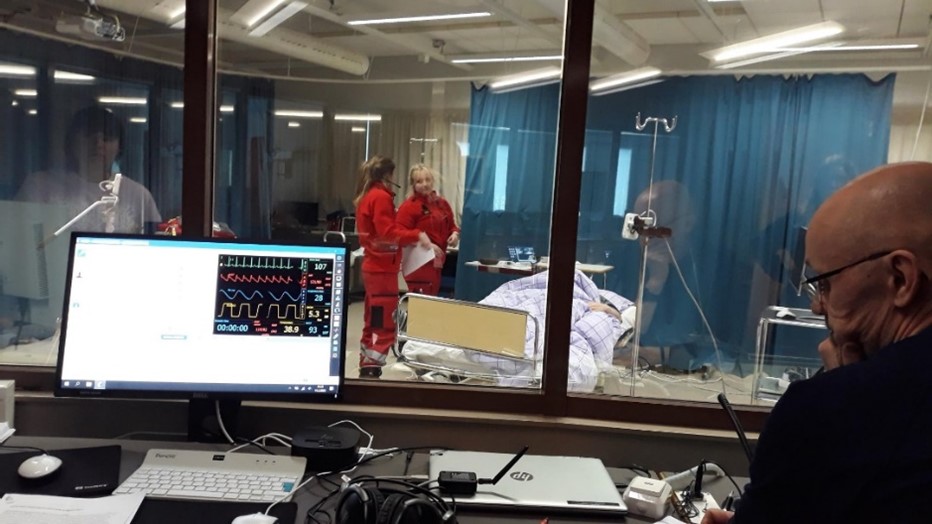
(Photo: Jaana Pantsari)
During the training days, trainers and the required number of paramedics came to Karelia UAS’s Simula facility. At the beginning of the training day, remote connections to different rescue stations were tested and the contents and schedule of the training day were explained. It was emphasised to everyone that the training day is an exercise, not a test. Engaging theory areas and equipment training were implemented before the simulation exercise, in which the lessons learned were applied in practice. Contact-participating paramedics were actors in simulation exercises. Follow-up tasks were also given to remote participants at different rescue stations, which allowed them to participate in the teaching discussion after the simulation exercise with contact participants and trainers. On the first day of the training, remote technology problems slightly delayed the smooth progress of the training, but the problems were resolved and no longer occurring on the next training days.
Participants’ feedback on the emergency medical services -1 (EMS1) training day
At the end of the training days, the contact and remote participants were asked to provide feedback on the training day. The feedback survey and a summary of the results of the feedback received were produced by Karelia’s master’s degree students as part of their future thesis. In their thesis, they analysed the experiences of older paramedics (over 45 years) in the training organised as contact and remote participation.
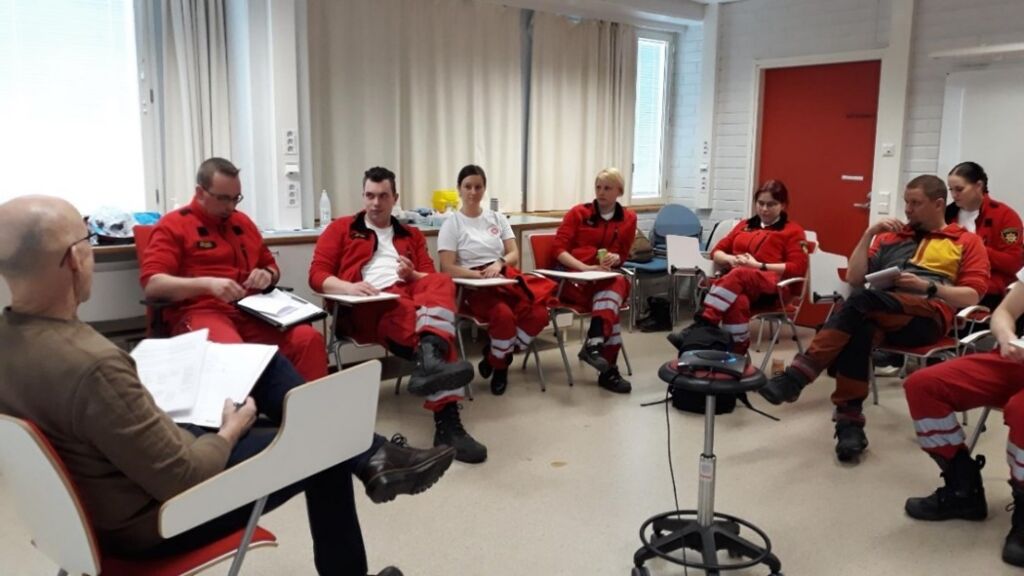
(Photo: Jaana Pantsari)
Feedback was collected through a Webropol survey, and 110 responses were received from participants in the EMS1 training (N=214). 55% of the respondents felt that participation in the hybrid training method was a better way to participate than training implemented as contact teaching:
“The option to participate remotely and develop effective education in all aspects is sensible.”
“It was possible to focus on the simulation exercises and observe things better when the event was organised remotely.”
During the hybrid training days, one quarter of the participants were in Simula and the rest participated remotely. During two training sessions, the participants were only in Simula due to the smaller total number of participants.
The results showed that most paramedics had participated in simulation training earlier. Only 10 % of the respondents had no previous experience of simulations. Based on previous simulation experience, the simulation was perceived as an effective learning method in open feedback, even though the simulation experiences varied by individual:
“Simulation learning is still a good way to learn.”
“I can’t think of anything good to say about simulation-type training, it just doesn’t suit for everyone.”
“More simulations and more equipment should be discussed. Everyone should be able to join the simulations.”
A lot of advance material had been made for the EMS1 training days, and most respondents felt that they supported the achievement of the training day’s objectives if only they had had the time to read them before the training:
“The advance study material was comprehensive and I am sure it properly prepared those who read it for the training.”
Most respondents felt that the content of the training day was suitable and that the objectives were achieved, although opposing opinions were also voiced:
“Things that were new to me were brought to the training day and they were interesting, and I will certainly need them at work.”
“The topics were way too demanding for the EMS1 day. After all, everyone participates in the training, fire chiefs/rescuers and paramedics (basic and advanced level)!”
The structure of the training day was considered good:
“The teaching lectures before simulations were good”.
The trainers received very good feedback on their activities:
“The trainers were clear and the contents of the topics were brought up very well. They knew how to present and teach them clearly and highlight the most important issues.”
“didn’t have a test feeling”
“The training day had a relaxed atmosphere and there was no need to be afraid of making mistakes.”
Consideration of remote participants during hybrid training was found to have been well realised:
“Big kudos for the trainers! Energetic activities and taking all participants into account as well as showing interest in what they brought up.”
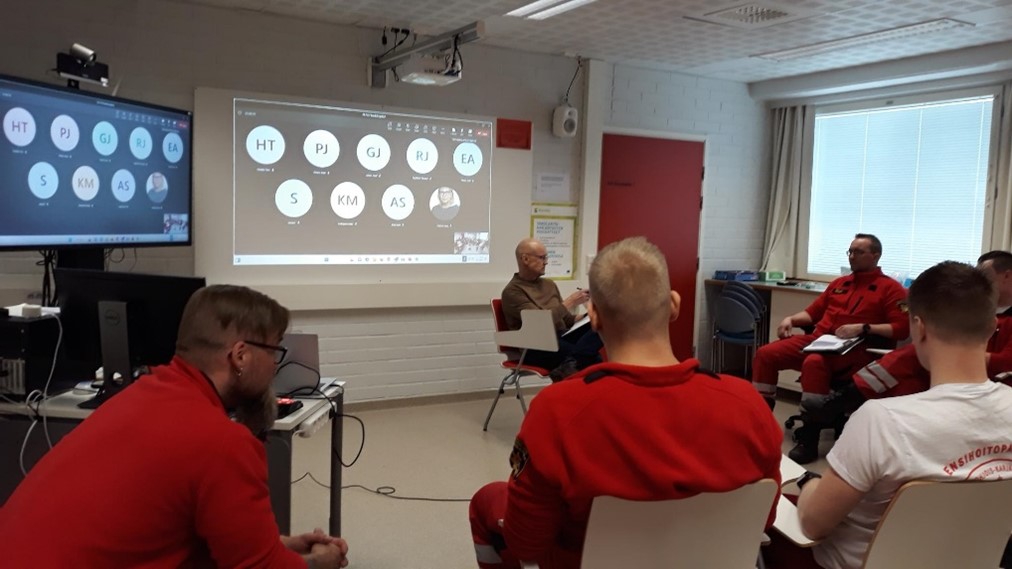
(Photo: Jaana Pantsari)
Improvement of technology was highlighted in the development proposals
There was also room for improvement in the implementation of the training day. Based on the feedback, the image conveyed from the debriefing space to remote participants was not always clear. During device training, transmitting the image to remote participants was changed to a portable camera connection, and keeping the image stable was challenging until the choice of camera with its support legs was correct. Hearing the voice was also a challenge for remote participants, especially when the participants in the simulations spoke at the same time, the speech was not clear – this was also a problem for contact participants:
“In many cases, it was not possible to understand the speech in simulations remotely, and relatively small screens made it difficult to follow events, so situational awareness was rather vague from time to time.”
Some improvement was accomplished through instructions and taking turns at speaking. A microphone was commissioned for the instructions sent from the control room, and the speech was communicated better through it to remote participants. On the first day of the training, there were technical issues with Simula and no technical specialist service was available, so a little more time was spent solving the problem. On other training days, there were no problems with remote-connection technology.
Rescue stations have joined the Security Network (TUVE) as part of the public administration’s security network activities. The operation of the TUVE network must not be compromised, for example by using a Teams connection in this network (Ministry of Finance). For this reason, the remotely participating rescue stations had their own challenges in seeing the image and hearing the sound when different devices and network connections were used for the Teams connection:
“If certain locations have difficulty with audio or video, would it be appropriate to revise at the network connections and speeds of the stations as well as audio and video devices to meet current video playback requirements?”
Overall, people were satisfied with the training days:
“Important topics, support field work well. Karelia’s simulation facilities as part of the training are really good.”
Based on the feedback, development measures were already carried out after the first training day. In the future, camera views based on different training needs should be taken even more into account in advance. Teaching videos on device training could be made for advance self-study, and they would support the instruction of devices in use during the training day, as the necessary number of devices and equipment would be available. The amount of self-study material should be taken into account, and sufficient time should be ensured for everyone to go through it. Solutions should be found for better hearing of sound by those on a remote connection; one option could be to try reducing the number of microphones during the simulation exercise, so that the most important voices in terms of teaching would be heard better.
In addition, more even distribution of remote participants to different training days should be considered, so that the number of remote participants would not be too large for some training days. A “support person” should be ensured at remote stations to ensure technical connectivity and general arrangements during the training day. This was implemented as planned at some rescue stations. In simulation facilities, it should be noted that a technical specialist would be available to support the activities and solve technical problems if necessary.
Implementation of first response training evenings and feedback
The planning of the First Response Unit (FRU) personnel training began in cooperation with the two health-sector teachers of Karelia UAS participating in the Living Lab project and the persons in charge of the first response training (emergency field directors and expert paramedics). The planning and implementation of the emergency medical services -1 (EMS1) training were used in the planning of first response unit personnel training evenings. Five FRU training evenings were organised, three hours at a time.
The structure of the training was designed in accordance with the DrcABCDE protocol, and occupational safety was a cross-cutting theme in all simulation exercises. Participants in the FRU training evenings were mainly First Response Unit personnel (contract rescuers) involved in first response activities, but in addition to them, training participants also included on-shift paramedics at rescue stations, to the extent of their own interest. In addition to the trainers, Karelia’s Simula had four to six contract rescuers per training evening, and on average, 30 to 60 participants per training evening from different rescue stations in the region were involved in remote connections.
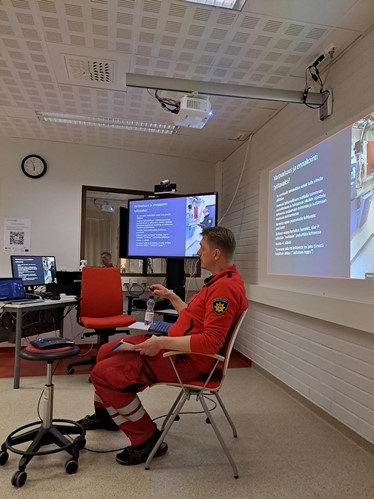
At the beginning of the training evening, remote connections to different rescue stations were tested and the contents and schedule of the training evening were explained. It was emphasised to everyone that the training day is an exercise, not a test. On the first training evening, everyone was told how to act in simulation exercises, as the contract firefighters had no prior experience of participating in simulation exercises.
At the beginning of the training evening, the trainers lectured on the theory related to the theme, followed by an applied simulation exercise. The three-hour FRU training included two themes with exercises. Contact participants were actors in the simulation exercises, and those who participated remotely received monitoring tasks during the simulation exercises and participated in teaching discussions after the simulation exercises, together with the contact participants and trainers. At the end of the training evenings, the contact and remote participants were asked to provide feedback on the training and its implementation. Two health-sector teachers in the Living Lab project produced a feedback survey and a summary of the results of the feedback received.
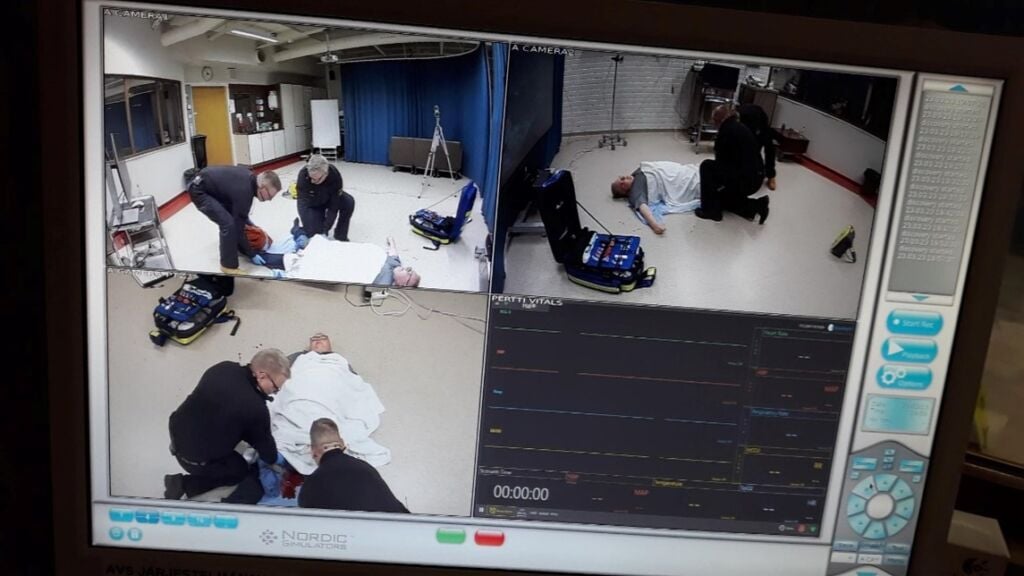
(Photo: Jaana Pantsari)
A total of 60 participants gave feedback on FRU training evenings (N=201). The number of participants in each training evening varied; some participated in each training evening, some in one or more. The experience of participating in first response activities varied greatly. Some had only just started with their first response activities, and some had more than five years of operating experience. Only a few participants had a degree in health care, and they could include even paramedics.
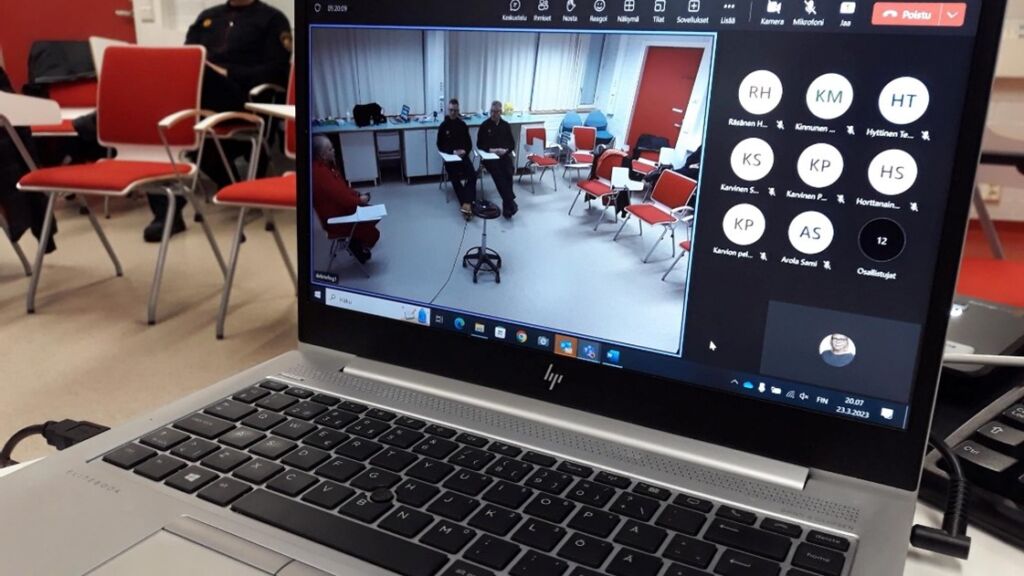
(Photo: Jaana Pantsari)
The feedback was analysed after each training evening, and the necessary development measures were carried out immediately. For example, the teaching discussions held after the simulation exercises were scheduled as more concise entities. Voice audibility was a challenge, as was the case with the EMS1 training days. A microphone was added for the instructions given from the control room to improve the audibility of voice to remote participants. A technical problem occurred on one training evening, but it was resolved quickly. There were no technical problems on other training evenings.
Based on the feedback received, contract rescuers considered the FRU training evenings implemented as a hybrid form to be a functional implementation method with a suitable level of requirements, including simulation exercises. The objectives of the training were achieved, the things to be taught were learned and everyone’s participation was successful during the training. Enthusiasm for participating in simulation exercises increased as a result of the training evenings and the experience gained from them. Participation in simulation exercises was considered positive, and the participants were given feedback through positive development in a good spirit:
“Increasing the number of contact days and creating an established operating method! Enabling FRU simulations in the future!!”
Hybrid simulation training will expand in the autumn
The EMS1 and FRU trainings piloted through the Living Lab project as contact and remote participation were successful. The structure of the training days was well planned for learning; the theory and equipment exercises supported an applied simulation exercise. Almost all paramedics had experience of participating in simulation exercises earlier. However, taking part in a simulation exercise as a professional seemed to be a more exciting experience based on the feedback, as remote participants were also involved. In addition, paramedics participating remotely brought up the pressurised situation of their paramedic colleagues participating in the simulation exercise. This phenomenon identified in the experiences of professionals is interesting, as, for example, based on feedback given as a student, participation in simulations has not generally been considered so pressured.
Karelia UAS has implemented simulation exercises for nursing students as hybrid teaching in supplementary studies in acute nursing. Some of the students have participated in simulation exercises remotely, and some have come to the school for contact implementation and participated in simulation exercises as actors. The feedback given by nursing students on the implementation of the simulation hybrid training in spring 2023 was positive, regardless of whether the participant was on-site or remote (Hirvonen 2023). The involvement of remote participants was not perceived as a pressure factor during the simulation exercises, even though the studies included unfamiliar students from different groups. Based on the feedback, paramedics taking part in the EMS1 training who had no previous experience in simulations liked the hybrid training method implemented as contact and distance participation better than paramedics with previous experience in simulations. Contract rescuers who participated in the first response unit (FRU) personnel training did not have previous experience in simulations, and they were really enthusiastic about simulation exercises and hybrid training.
What factors can affect this perceived pressure phenomenon? Have any negative experiences been gained during previous simulation exercises, and do they affect the origin of the phenomenon? Or is the mindset that a professional should not fail during a simulation exercise – especially with colleagues watching? Perhaps the participants only have experience of simulations implemented as contact participation, and it is perceived as a less pressurised exercise situation than one where colleagues participate in a joint exercise remotely?
If hybrid remote and contact simulation training is to be used in different fields and in a country of long distances, all simulation instructors and participants should contribute to obtaining better experiences from simulation exercises. Practical training should be emphasised instead of tests. Even professionals are also learning new things together and sharing competence. Feedback should always be given positively. Possible errors can also be handled without blame, and follow-up talk about simulation exercises should be omitted. We can all influence these matters. When an atmosphere is created where one genuinely dares to learn together in a safe, simulated exercise environment, more gains than losses will be achieved – be it a small number of participants in a contact implementation or a larger number of remote participants simultaneously.
In autumn 2023, the cooperation with North Karelia’s emergency medical care will continue and expand. The Emergency medical services -2 training days (EMS2) will be attended by 157 paramedics (advanced level) and around 70 nurses and doctors from the joint emergency care, emergency ward and emergency assistance counselling and guidance services from Siun Sote. (Törrönen 2023b) The planning of the training days has already begun.
Of these training processes, the Living Lab project will produce a service structure model that can be used in cooperation with businesses in the educational service needs of different organisations and companies, especially in areas of long distances, both nationally and internationally.
Author:
Jaana Pantsari, lecturer, nurse training, Karelia University of Applied Sciences
Sources:
Ahlgren, R., Häkkinen, S., Koskinen, M., Laakso, H., Selkivuori, L. 2020. Havaintoja hybridiopetuksesta. JAMK University of Applied Sciences. https://oppimateriaalit.jamk.fi/hybridiopetus/opettajan-identiteetti/ 16 May 2023
Enlund, J. & Huhtiniemi, J. 2021. Simulaatio-oppiminen terveysalan opinnoissa : Kuvaileva kirjallisuuskatsaus. Thesis. Nurse training. JAMK University of Applied Sciences. https://urn.fi/URN:NBN:fi:amk-202105046997 16 May 2023
Hirvonen, T. 2023. Hybridiopetuksen osallistavat opetusmenetelmät terveysalan simulaatio-opetuksessa. Master’s thesis. Nursing science. University of Eastern Finland. https://erepo.uef.fi/handle/123456789/30281 24.8.2023
Kurki, J. and Leppänen, S. 2022. Living lab – Yhteiskehittämisen mahdollisuuksia Pohjois-Karjalan alueella. Pulssi portal 19 December 2021. Karelia University of Applied Sciences. https://www.karelia.fi/2022/12/living-lab-yhteiskehittamisen-mahdollisuuksia-pohjois-karjalan-alueella/ 15 May 2023
Pantsari, J. 2022. Uusi etäosallistumisen mahdollisuus avaa Simulan eri koulutusalojen ja työelämän käyttöön. Pulssi portal 21 April 2022. Karelia University of Applied Sciences. https://karelia.fi/2022/04/uusi-etaosallistumisen-mahdollisuus-avaa-simulan-eri-koulutusalojen-ja-tyoelaman-kayttoon/ 15 May 2023
Rescue services. Emergency care. https://pelastustoimi.fi/pohjois-karjala/palvelut/ensihoito 15 May 2023
Salonen, H. 2013. Mitä simulaatiolla tulisi ensihoidon koulutuksissa opettaa – ryhmähaastattelu ensihoidon simulaatio-opetuksen asiantuntijoille. Master’s thesis. Department of Nursing Science. University of Eastern Finland. https://core.ac.uk/download/pdf/15170406.pdf 16 May 2023
Health Care Act 1326/2010 https://www.finlex.fi/fi/laki/kaannokset/2010/en20101326 15 May 2023
Törrönen, K. 2023a. Head of Emergency Care, North Karelia Rescue Department. Interview 17 May 2023.
Törrönen, K. 2023b. Head of Emergency Care, North Karelia Rescue Department. Interview 25 May 2023.
University of Aberdeen Industrial Psychology Research Centre and the Scottish Clinical Simulation Centre. 2012. Framework for Observing and Rating Anaesthetists’ Non-Technical Skills. https://www.jeehp.org/upload/media/jeehp-13-44-supple1.pdf 16 May 2023
Ministry of Finance. Julkisen hallinnon turvallisuusverkkotoiminta (TUVE-toiminta). https://vm.fi/turvallisuusverkkotoiminta 1 June 2023

